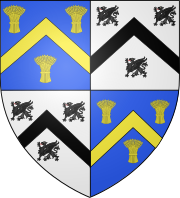
Back Earl of Nottingham German Comte de Nottingham French Conte di Nottingham Italian ノッティンガム伯爵 Japanese Graaf van Nottingham Dutch Hrabiowie Nottingham Polish Conde de Nottingham Portuguese Граф Ноттингем Russian
- See also Earl of Winchilsea
| Earldom of Nottingham held with Earldom of Winchilsea | |
|---|---|
  Arms of Finch-Hatton, Earl of Winchilsea and Earl of Nottingham Quarterly, 1st & 4th: argent, a chevron between three garbs gules; (Hatton) 2nd & 3rd, argent, a chevron between three griffins, passant, wings endorsed sable (Finch) | |
| Creation date | 1377 (first creation) 1383 (second creation) 1476 (third creation) 1483 (fourth creation) 1525 (fifth creation) 1596 (sixth creation) 1681 (seventh creation) |
| Created by | Richard II (first and second creations) Edward IV (third creation) Edward V (fourth creation) Henry VIII (fifth creation) Elizabeth I (sixth creation) Charles II (seventh creation) |
| Peerage | Peerage of England |
| First holder | John de Mowbray |
| Present holder | Daniel Finch-Hatton, 17th Earl of Winchilsea, 12th Earl of Nottingham |
| Heir apparent | Tobias Finch-Hatton, Viscount Maidstone |
| Remainder to | the 1st Earl's heirs male whatsoever |
| Subsidiary titles | Viscount Maidstone Baron Finch of Daventry Baronet of Eastwell Baronet of Raunston |
| Extinction date | 1383 (first creation) 1476 (second creation) 1483 (third creation) 1492 (fourth creation) 1536 (fifth creation) 1681 (sixth creation) |
| Seat(s) | Kirby Hall |
| Former seat(s) | Eastwell Park |
| Motto | Nil conscire sibi ("Conscious of no evil"); Virtus tutissima cassis ("Virtue is the safest helmet") |
Earl of Nottingham is a title that has been created seven times in the Peerage of England.[1] It was first created for John de Mowbray in 1377, at the coronation of Richard II. As this creation could only pass to his legitimate heirs, it went extinct on his death in 1383. It was re-created for his younger brother Thomas de Mowbray in the same year, however. This branch of the family became Dukes of Norfolk, and the title would descend with them until John de Mowbray died without male heirs in 1476.
The third creation was for Richard of Shrewsbury, Duke of York, son of Edward IV and one of the Princes in the Tower. Richard was imprisoned by his uncle Richard III (then Lord Protector), disappearing shortly after, presumed murdered.
The earldom was briefly recreated in 1483 for the 4th time for William Berkeley, who later became Marquess of Berkeley. Then in 1525, the earldom was recreated for the 5th time for Henry Fitzroy, Duke of Richmond and Somerset and illegitimate son of Henry VIII. Both died childless within ten years of being granted the title.
The sixth creation was for Charles Howard, Lord High Admiral for Elizabeth I and James VI and I. He was commander of the English navy against the Spanish Armada, and a notable statesman in both reigns. His descendants held the earldom until 1681.
The current, seventh, creation was made in 1681 for Heneage Finch, 1st Earl of Nottingham, who died one year later. Before being created earl he was the Attorney General and Lord Chancellor, and played an active part in the aftermath of the Popish Plot. His son Daniel Finch inherited the Earldom of Winchilsea in 1729. The second earl was a prominent politician, serving as Lord President of the Council, Secretary of State for the Northern and Southern Departments, and First Lord of the Admiralty.
For subsequent family history, see Earl of Winchilsea and Nottingham.
The title is currently held by Daniel Finch-Hatton, 17th Earl of Winchilsea and 12th Earl of Nottingham.
- ^ Chisholm, Hugh, ed. (1911). . Encyclopædia Britannica. Vol. 19 (11th ed.). Cambridge University Press. pp. 824–825.